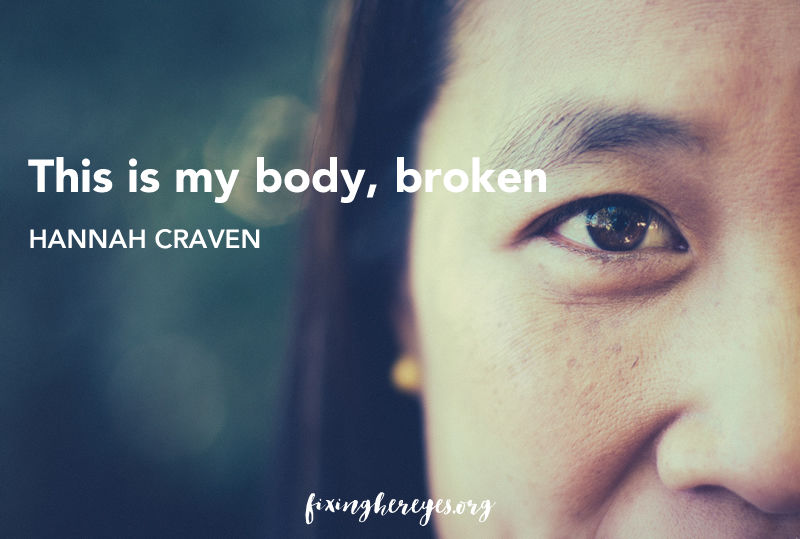This is my body, broken

This is my body, broken for you. Do this in remembrance of me.
Every Sunday as we gather around the communion table, we hear these words.
We remember Christ’s body broken.
We remember his blood poured out.
We make visible his suffering.
And yet, as we gather around that table… as we stand from our seats and walk forward to receive the bread and the wine, I wonder about the suffering that we render invisible.
Each week as the church family gathers around its symbols of body and blood, somewhere in Australia a woman’s family gathers around another broken body. The body of a woman killed by her partner.
Her body broken.
Her blood poured out.
Each week as the minister lifts the cloth to reveal the bread and wine, women in our congregations hide their own bruised bodies under sleeves and scarves and skirts.
Each week as the leader declares forgiveness of sins, love, grace, and freedom, women return home to husbands who control, manipulate, hurt, and abuse.
What are we to say?
We women, whose bodies are violated.
Whose suffering is rendered invisible.
Whose cries are not heard.
What are we to say?
How are we to feel?
As we gather around that table? Rehearsing the sufferings of Christ, whilst relegating our own?
And what does the broken body of Christ say to us?
The words of Isaiah remind us that, in his death, Jesus didn’t just bear our sins, he also bore our suffering and our shame.
“Surely he took up our pain,
and bore our suffering.” (Isaiah 53:4) He knows and feels what we know and feel. His wounds are our wounds. Our God is a suffering God. And so the suffering of women is, Elizabeth Johnson writes, in some “unspeakable way,” an image of the crucified Jesus.
Women are, in their very being, but also especially in their suffering, the imago Dei, the image of God. “[G]od enters in to the pain of women whose humanity is profaned and keeps vigil with the godforsaken for whom there is no rescue. In turn, their devastation points to the depths of the suffering God.”[1]” Dietrich Bonhoeffer wrote that ‘only a suffering God can help’ because only a suffering God is truly with us where we are. “[God] identifies with the pain and violence that women experience on the cross of whatever sort…. When a woman is raped and murdered… [God] says, my body is heavy with violation. Through the long night when the Bethlehem concubine [Judges 19] is gang-raped and tortured… [God] is there, being abused and defiled.”[2] So what then of this meal in which we participate each week? Can we name it as Johnson does? Speak it aloud in our sacred halls? Whisper it within to our frightened hearts? “The suffering body of Christ includes the raped and denigrated bodies of women.”[3] So, if you gather at church, your pain unvoiced, your suffering unrecognised, your bruises hidden. Know this: As you remember the sufferings of Christ, represented by the bread and wine, the symbols of his body and blood…. God remembers you. Your sufferings too, are represented there, in the bread and wine And God knows. God knows. God sees. God hears. God feels. God weeps. God is broken too.
If you are experiencing Domestic Violence and are afraid for your safety, seek help from a trusted friend or counsellor, or call the National Sexual Assault and Domestic Violence Counselling Service on 1800 RESPECT. Visit our Resources page for further help. If you are in danger in your home, please call 000 (if in Australia).
[1] Elizabeth Johnson, She Who Is: The Mystery of God in Feminist Theological Discourse (New York: Crossroad, 1992), 264. [2] Johnson, She Who Is, 264. [3] Ibid., 264.
Hannah Craven is an Anglican minister in a church in North Carlton - on the fringe of Melbourne city. Wife to Tom & mother to Liam & Amber.




















